ACCT6008: Cost Allocation and Job Order Costing - Week 4 Notes
VerifiedAdded on 2024/04/29
|26
|5222
|55
Homework Assignment
AI Summary
These ACCT6008 Week 4 notes cover conventional cost allocation and job order costing, crucial for both manufacturing and service firms. The notes detail the flow of costs in a manufacturing environment, distinguishing between product and period costs, as well as direct and indirect costs. Key concepts such as variable and fixed costs, cost drivers, and cost allocation bases are explained, along with the differences between process costing and job-order costing systems. The document outlines the steps involved in job costing, including identifying cost objects, allocating overhead costs, and computing total job costs. It further discusses actual versus normal costing, underapplied and overapplied overhead, and the preparation of cost of goods manufactured and sold schedules, concluding with the presentation of an income statement for a manufacturer. Desklib provides access to a wide range of study resources, including past papers and solved assignments, to support students in mastering these concepts.
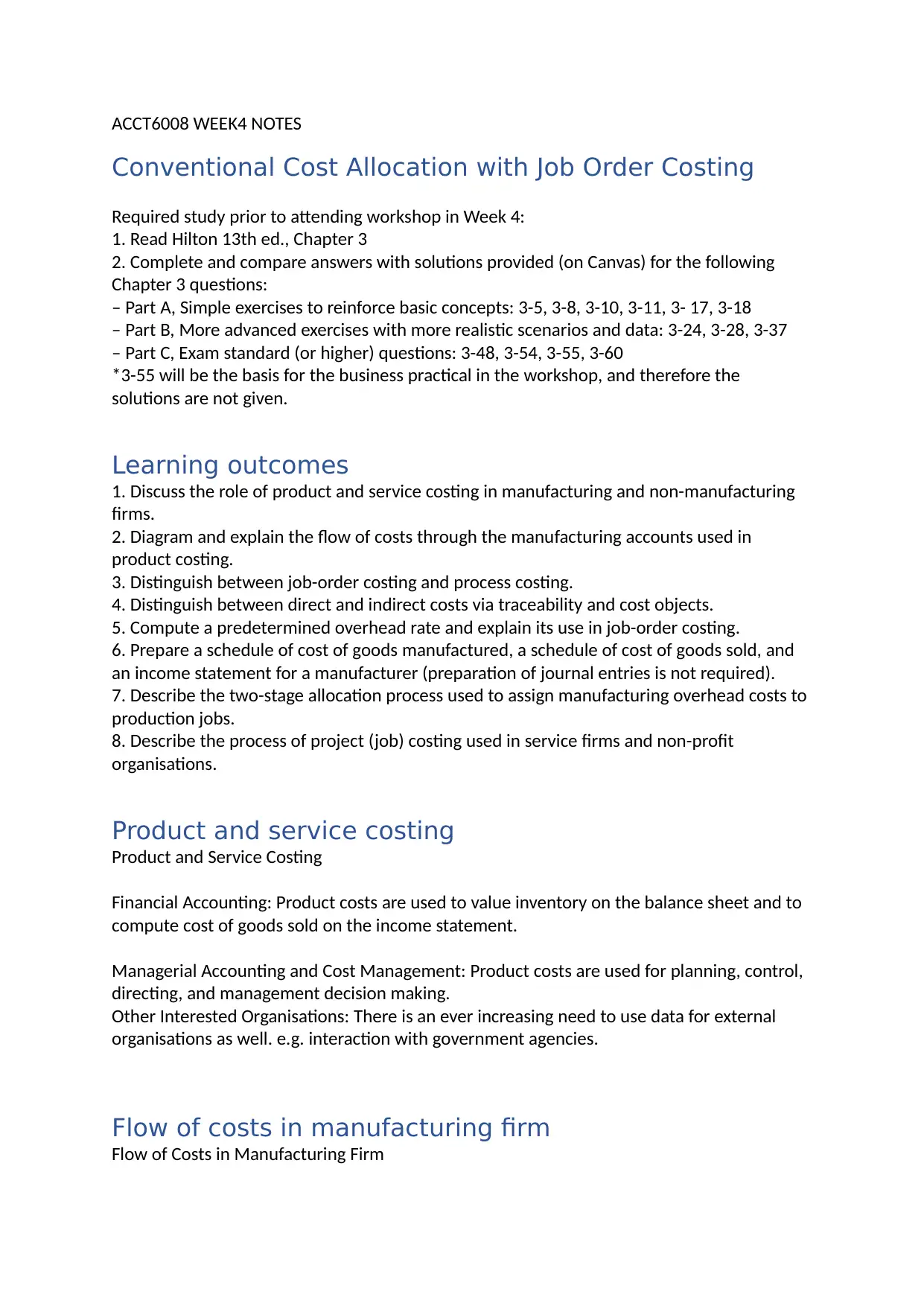
ACCT6008 WEEK4 NOTES
Conventional Cost Allocation with Job Order Costing
Required study prior to attending workshop in Week 4:
1. Read Hilton 13th ed., Chapter 3
2. Complete and compare answers with solutions provided (on Canvas) for the following
Chapter 3 questions:
– Part A, Simple exercises to reinforce basic concepts: 3-5, 3-8, 3-10, 3-11, 3- 17, 3-18
– Part B, More advanced exercises with more realistic scenarios and data: 3-24, 3-28, 3-37
– Part C, Exam standard (or higher) questions: 3-48, 3-54, 3-55, 3-60
*3-55 will be the basis for the business practical in the workshop, and therefore the
solutions are not given.
Learning outcomes
1. Discuss the role of product and service costing in manufacturing and non-manufacturing
firms.
2. Diagram and explain the flow of costs through the manufacturing accounts used in
product costing.
3. Distinguish between job-order costing and process costing.
4. Distinguish between direct and indirect costs via traceability and cost objects.
5. Compute a predetermined overhead rate and explain its use in job-order costing.
6. Prepare a schedule of cost of goods manufactured, a schedule of cost of goods sold, and
an income statement for a manufacturer (preparation of journal entries is not required).
7. Describe the two-stage allocation process used to assign manufacturing overhead costs to
production jobs.
8. Describe the process of project (job) costing used in service firms and non-profit
organisations.
Product and service costing
Product and Service Costing
Financial Accounting: Product costs are used to value inventory on the balance sheet and to
compute cost of goods sold on the income statement.
Managerial Accounting and Cost Management: Product costs are used for planning, control,
directing, and management decision making.
Other Interested Organisations: There is an ever increasing need to use data for external
organisations as well. e.g. interaction with government agencies.
Flow of costs in manufacturing firm
Flow of Costs in Manufacturing Firm
Conventional Cost Allocation with Job Order Costing
Required study prior to attending workshop in Week 4:
1. Read Hilton 13th ed., Chapter 3
2. Complete and compare answers with solutions provided (on Canvas) for the following
Chapter 3 questions:
– Part A, Simple exercises to reinforce basic concepts: 3-5, 3-8, 3-10, 3-11, 3- 17, 3-18
– Part B, More advanced exercises with more realistic scenarios and data: 3-24, 3-28, 3-37
– Part C, Exam standard (or higher) questions: 3-48, 3-54, 3-55, 3-60
*3-55 will be the basis for the business practical in the workshop, and therefore the
solutions are not given.
Learning outcomes
1. Discuss the role of product and service costing in manufacturing and non-manufacturing
firms.
2. Diagram and explain the flow of costs through the manufacturing accounts used in
product costing.
3. Distinguish between job-order costing and process costing.
4. Distinguish between direct and indirect costs via traceability and cost objects.
5. Compute a predetermined overhead rate and explain its use in job-order costing.
6. Prepare a schedule of cost of goods manufactured, a schedule of cost of goods sold, and
an income statement for a manufacturer (preparation of journal entries is not required).
7. Describe the two-stage allocation process used to assign manufacturing overhead costs to
production jobs.
8. Describe the process of project (job) costing used in service firms and non-profit
organisations.
Product and service costing
Product and Service Costing
Financial Accounting: Product costs are used to value inventory on the balance sheet and to
compute cost of goods sold on the income statement.
Managerial Accounting and Cost Management: Product costs are used for planning, control,
directing, and management decision making.
Other Interested Organisations: There is an ever increasing need to use data for external
organisations as well. e.g. interaction with government agencies.
Flow of costs in manufacturing firm
Flow of Costs in Manufacturing Firm
Paraphrase This Document
Need a fresh take? Get an instant paraphrase of this document with our AI Paraphraser
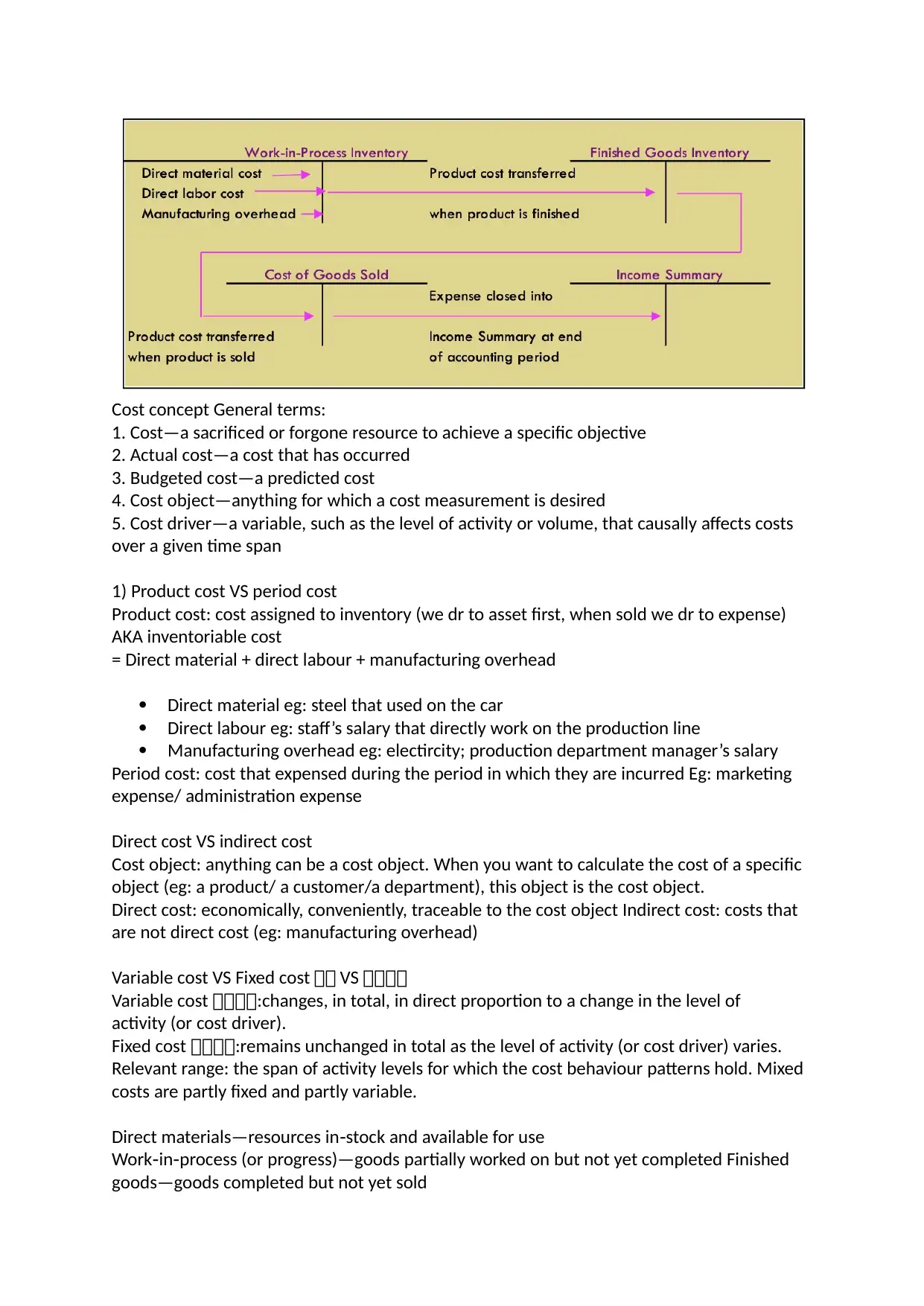
Cost concept General terms:
1. Cost—a sacrificed or forgone resource to achieve a specific objective
2. Actual cost—a cost that has occurred
3. Budgeted cost—a predicted cost
4. Cost object—anything for which a cost measurement is desired
5. Cost driver—a variable, such as the level of activity or volume, that causally affects costs
over a given time span
1) Product cost VS period cost
Product cost: cost assigned to inventory (we dr to asset first, when sold we dr to expense)
AKA inventoriable cost
= Direct material + direct labour + manufacturing overhead
Direct material eg: steel that used on the car
Direct labour eg: staff’s salary that directly work on the production line
Manufacturing overhead eg: electircity; production department manager’s salary
Period cost: cost that expensed during the period in which they are incurred Eg: marketing
expense/ administration expense
Direct cost VS indirect cost
Cost object: anything can be a cost object. When you want to calculate the cost of a specific
object (eg: a product/ a customer/a department), this object is the cost object.
Direct cost: economically, conveniently, traceable to the cost object Indirect cost: costs that
are not direct cost (eg: manufacturing overhead)
Variable cost VS Fixed cost 可可 VS 可可可可
Variable cost 可可可可:changes, in total, in direct proportion to a change in the level of
activity (or cost driver).
Fixed cost 可可可可:remains unchanged in total as the level of activity (or cost driver) varies.
Relevant range: the span of activity levels for which the cost behaviour patterns hold. Mixed
costs are partly fixed and partly variable.
Direct materials—resources in stock and available for use‐
Work in process (or progress)—goods partially worked on but not yet completed Finished‐ ‐
goods—goods completed but not yet sold
1. Cost—a sacrificed or forgone resource to achieve a specific objective
2. Actual cost—a cost that has occurred
3. Budgeted cost—a predicted cost
4. Cost object—anything for which a cost measurement is desired
5. Cost driver—a variable, such as the level of activity or volume, that causally affects costs
over a given time span
1) Product cost VS period cost
Product cost: cost assigned to inventory (we dr to asset first, when sold we dr to expense)
AKA inventoriable cost
= Direct material + direct labour + manufacturing overhead
Direct material eg: steel that used on the car
Direct labour eg: staff’s salary that directly work on the production line
Manufacturing overhead eg: electircity; production department manager’s salary
Period cost: cost that expensed during the period in which they are incurred Eg: marketing
expense/ administration expense
Direct cost VS indirect cost
Cost object: anything can be a cost object. When you want to calculate the cost of a specific
object (eg: a product/ a customer/a department), this object is the cost object.
Direct cost: economically, conveniently, traceable to the cost object Indirect cost: costs that
are not direct cost (eg: manufacturing overhead)
Variable cost VS Fixed cost 可可 VS 可可可可
Variable cost 可可可可:changes, in total, in direct proportion to a change in the level of
activity (or cost driver).
Fixed cost 可可可可:remains unchanged in total as the level of activity (or cost driver) varies.
Relevant range: the span of activity levels for which the cost behaviour patterns hold. Mixed
costs are partly fixed and partly variable.
Direct materials—resources in stock and available for use‐
Work in process (or progress)—goods partially worked on but not yet completed Finished‐ ‐
goods—goods completed but not yet sold
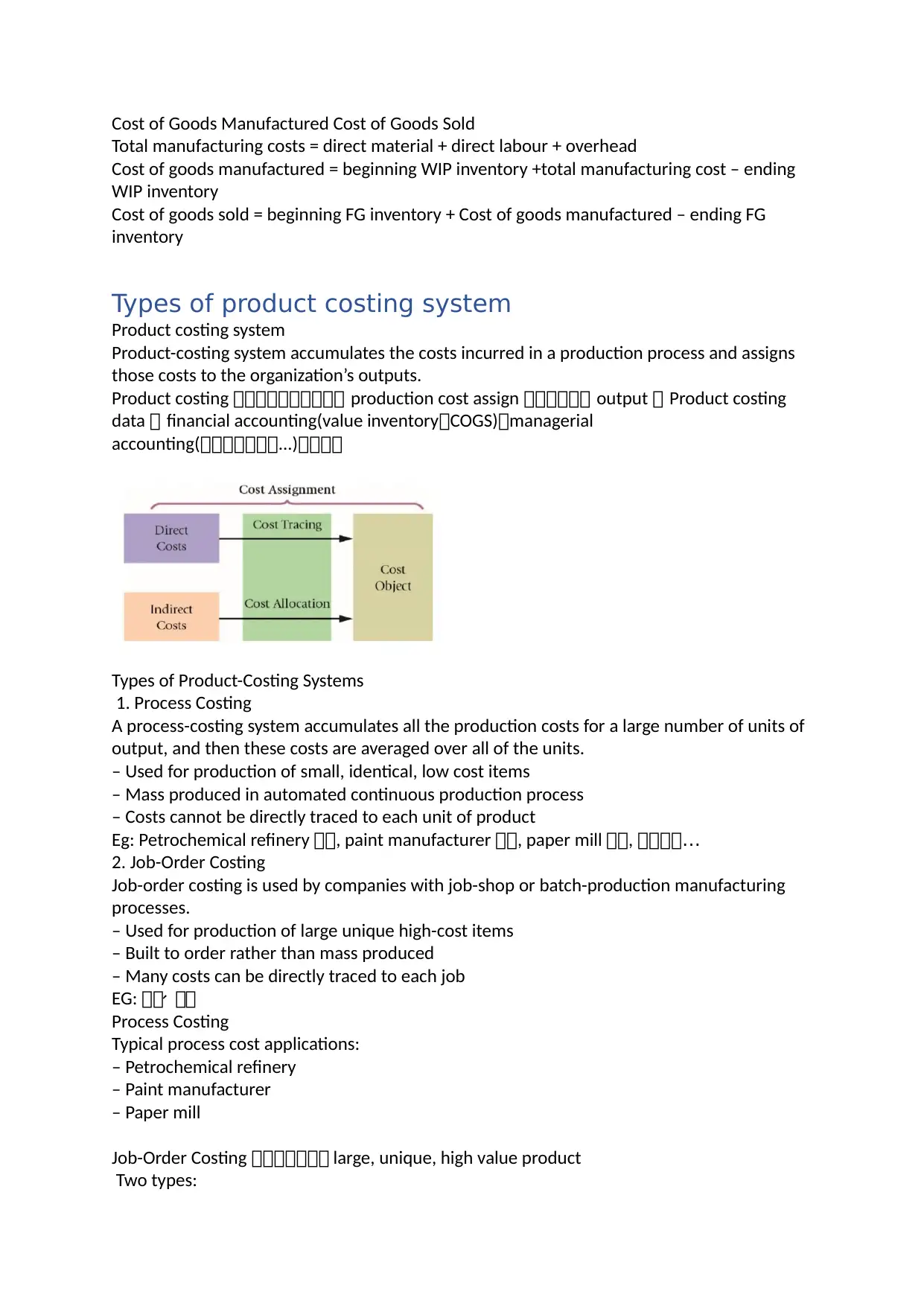
Cost of Goods Manufactured Cost of Goods Sold
Total manufacturing costs = direct material + direct labour + overhead
Cost of goods manufactured = beginning WIP inventory +total manufacturing cost – ending
WIP inventory
Cost of goods sold = beginning FG inventory + Cost of goods manufactured – ending FG
inventory
Types of product costing system
Product costing system
Product-costing system accumulates the costs incurred in a production process and assigns
those costs to the organization’s outputs.
Product costing 可可可可可可可可可可 production cost assign 可可可可可可 output 可 Product costing
data 可 financial accounting(value inventory可COGS)可managerial
accounting(可可可可可可可...)可可可可
Types of Product-Costing Systems
1. Process Costing
A process-costing system accumulates all the production costs for a large number of units of
output, and then these costs are averaged over all of the units.
– Used for production of small, identical, low cost items
– Mass produced in automated continuous production process
– Costs cannot be directly traced to each unit of product
Eg: Petrochemical refinery 可可, paint manufacturer 可可, paper mill 可可, 可可可可…
2. Job-Order Costing
Job-order costing is used by companies with job-shop or batch-production manufacturing
processes.
– Used for production of large unique high-cost items
– Built to order rather than mass produced
– Many costs can be directly traced to each job
EG: 可可 可可、
Process Costing
Typical process cost applications:
– Petrochemical refinery
– Paint manufacturer
– Paper mill
Job-Order Costing 可可可可可可可 large, unique, high value product
Two types:
Total manufacturing costs = direct material + direct labour + overhead
Cost of goods manufactured = beginning WIP inventory +total manufacturing cost – ending
WIP inventory
Cost of goods sold = beginning FG inventory + Cost of goods manufactured – ending FG
inventory
Types of product costing system
Product costing system
Product-costing system accumulates the costs incurred in a production process and assigns
those costs to the organization’s outputs.
Product costing 可可可可可可可可可可 production cost assign 可可可可可可 output 可 Product costing
data 可 financial accounting(value inventory可COGS)可managerial
accounting(可可可可可可可...)可可可可
Types of Product-Costing Systems
1. Process Costing
A process-costing system accumulates all the production costs for a large number of units of
output, and then these costs are averaged over all of the units.
– Used for production of small, identical, low cost items
– Mass produced in automated continuous production process
– Costs cannot be directly traced to each unit of product
Eg: Petrochemical refinery 可可, paint manufacturer 可可, paper mill 可可, 可可可可…
2. Job-Order Costing
Job-order costing is used by companies with job-shop or batch-production manufacturing
processes.
– Used for production of large unique high-cost items
– Built to order rather than mass produced
– Many costs can be directly traced to each job
EG: 可可 可可、
Process Costing
Typical process cost applications:
– Petrochemical refinery
– Paint manufacturer
– Paper mill
Job-Order Costing 可可可可可可可 large, unique, high value product
Two types:
⊘ This is a preview!⊘
Do you want full access?
Subscribe today to unlock all pages.

Trusted by 1+ million students worldwide
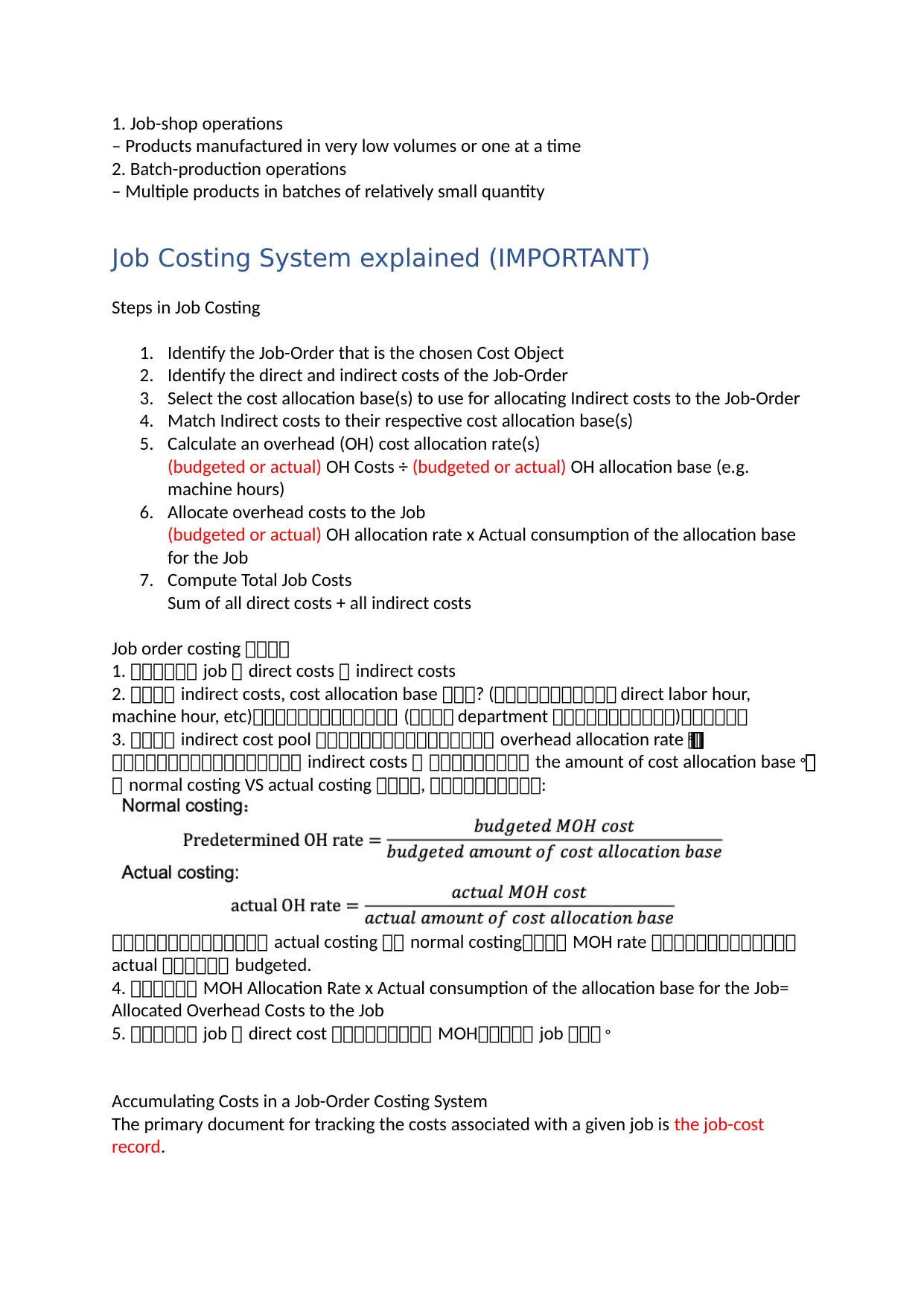
1. Job-shop operations
– Products manufactured in very low volumes or one at a time
2. Batch-production operations
– Multiple products in batches of relatively small quantity
Job Costing System explained (IMPORTANT)
Steps in Job Costing
1. Identify the Job-Order that is the chosen Cost Object
2. Identify the direct and indirect costs of the Job-Order
3. Select the cost allocation base(s) to use for allocating Indirect costs to the Job-Order
4. Match Indirect costs to their respective cost allocation base(s)
5. Calculate an overhead (OH) cost allocation rate(s)
(budgeted or actual) OH Costs ÷ (budgeted or actual) OH allocation base (e.g.
machine hours)
6. Allocate overhead costs to the Job
(budgeted or actual) OH allocation rate x Actual consumption of the allocation base
for the Job
7. Compute Total Job Costs
Sum of all direct costs + all indirect costs
Job order costing 可可可可
1. 可可可可可可 job 可 direct costs 可 indirect costs
2. 可可可可 indirect costs, cost allocation base 可可可? (可可可可可可可可可可可 direct labor hour,
machine hour, etc)可可可可可可可可可可可可可 (可可可可 department 可可可可可可可可可可可)可可可可可可
3. 可可可可 indirect cost pool 可可可可可可可可可可可可可可可可 overhead allocation rate 可可可可可可可可可可。
可可可可可可可可可可可可可可可可可 indirect costs 可 可可可可可可可可可 the amount of cost allocation base 可可可可可可。
可 normal costing VS actual costing 可可可可, 可可可可可可可可可可:
可可可可可可可可可可可可可可 actual costing 可可 normal costing可可可可 MOH rate 可可可可可可可可可可可可可
actual 可可可可可可 budgeted.
4. 可可可可可可 MOH Allocation Rate x Actual consumption of the allocation base for the Job=
Allocated Overhead Costs to the Job
5. 可可可可可可 job 可 direct cost 可可可可可可可可可 MOH可可可可可 job 可可可。
Accumulating Costs in a Job-Order Costing System
The primary document for tracking the costs associated with a given job is the job-cost
record.
– Products manufactured in very low volumes or one at a time
2. Batch-production operations
– Multiple products in batches of relatively small quantity
Job Costing System explained (IMPORTANT)
Steps in Job Costing
1. Identify the Job-Order that is the chosen Cost Object
2. Identify the direct and indirect costs of the Job-Order
3. Select the cost allocation base(s) to use for allocating Indirect costs to the Job-Order
4. Match Indirect costs to their respective cost allocation base(s)
5. Calculate an overhead (OH) cost allocation rate(s)
(budgeted or actual) OH Costs ÷ (budgeted or actual) OH allocation base (e.g.
machine hours)
6. Allocate overhead costs to the Job
(budgeted or actual) OH allocation rate x Actual consumption of the allocation base
for the Job
7. Compute Total Job Costs
Sum of all direct costs + all indirect costs
Job order costing 可可可可
1. 可可可可可可 job 可 direct costs 可 indirect costs
2. 可可可可 indirect costs, cost allocation base 可可可? (可可可可可可可可可可可 direct labor hour,
machine hour, etc)可可可可可可可可可可可可可 (可可可可 department 可可可可可可可可可可可)可可可可可可
3. 可可可可 indirect cost pool 可可可可可可可可可可可可可可可可 overhead allocation rate 可可可可可可可可可可。
可可可可可可可可可可可可可可可可可 indirect costs 可 可可可可可可可可可 the amount of cost allocation base 可可可可可可。
可 normal costing VS actual costing 可可可可, 可可可可可可可可可可:
可可可可可可可可可可可可可可 actual costing 可可 normal costing可可可可 MOH rate 可可可可可可可可可可可可可
actual 可可可可可可 budgeted.
4. 可可可可可可 MOH Allocation Rate x Actual consumption of the allocation base for the Job=
Allocated Overhead Costs to the Job
5. 可可可可可可 job 可 direct cost 可可可可可可可可可 MOH可可可可可 job 可可可。
Accumulating Costs in a Job-Order Costing System
The primary document for tracking the costs associated with a given job is the job-cost
record.
Paraphrase This Document
Need a fresh take? Get an instant paraphrase of this document with our AI Paraphraser
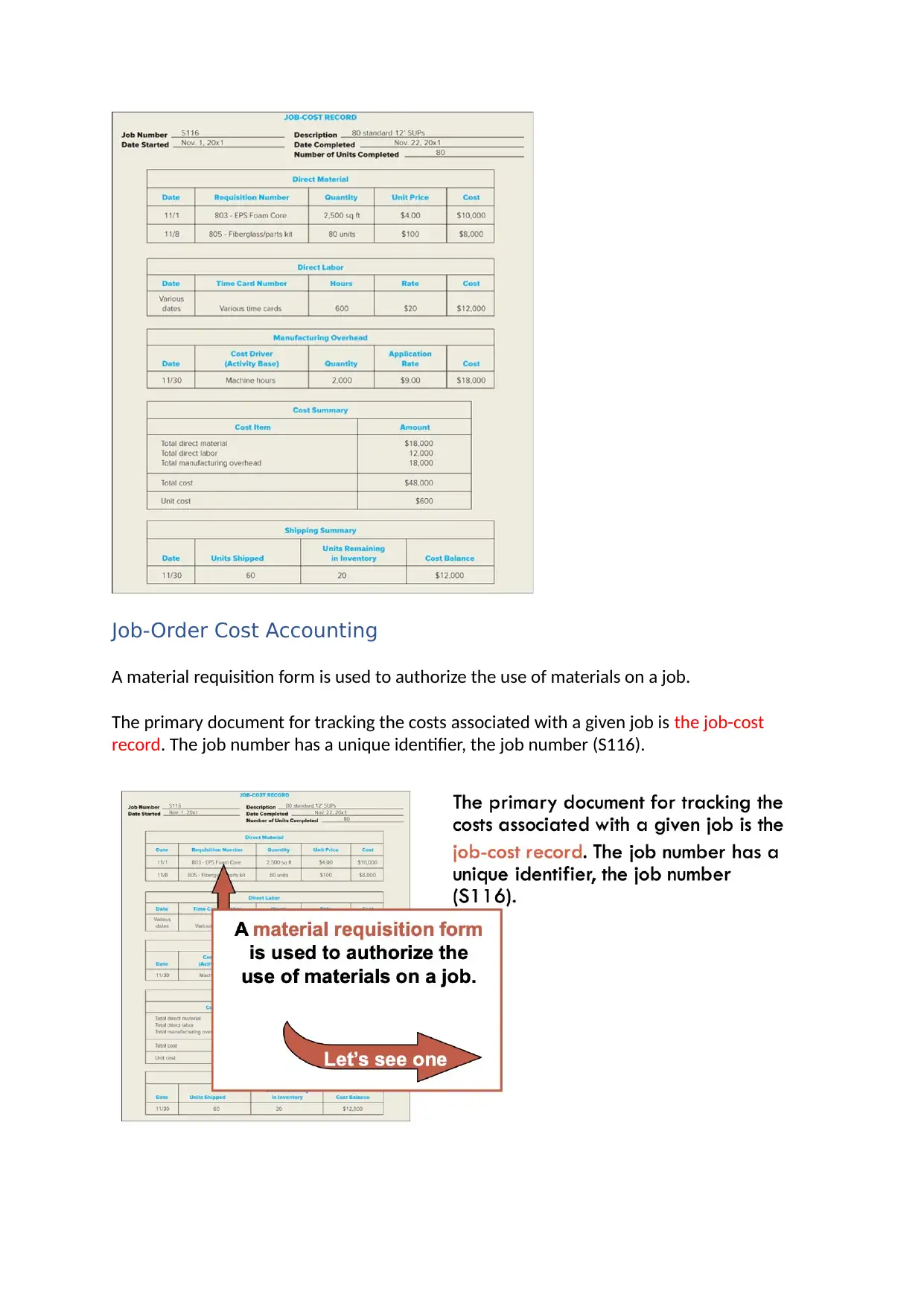
Job-Order Cost Accounting
A material requisition form is used to authorize the use of materials on a job.
The primary document for tracking the costs associated with a given job is the job-cost
record. The job number has a unique identifier, the job number (S116).
A material requisition form is used to authorize the use of materials on a job.
The primary document for tracking the costs associated with a given job is the job-cost
record. The job number has a unique identifier, the job number (S116).
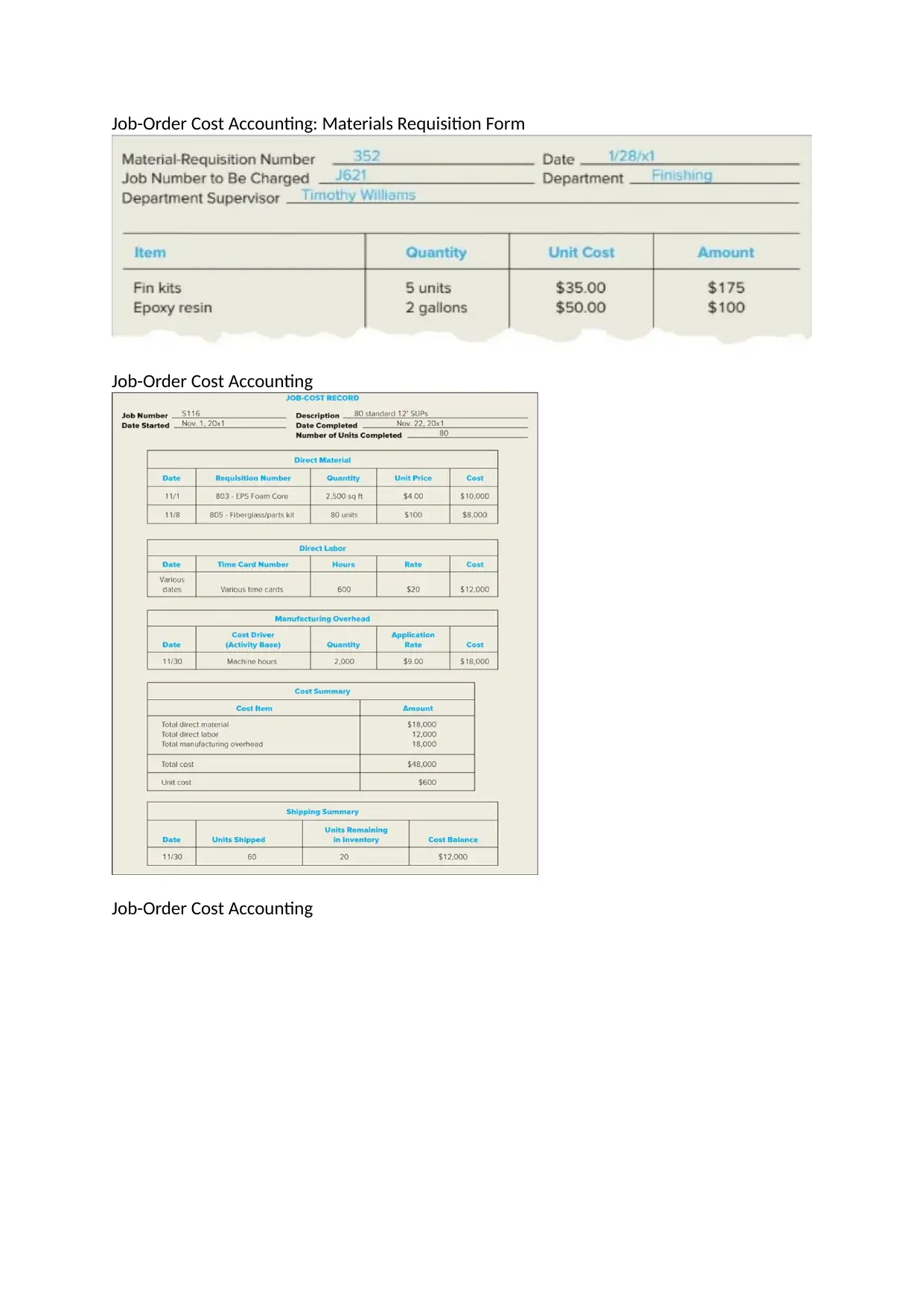
Job-Order Cost Accounting: Materials Requisition Form
Job-Order Cost Accounting
Job-Order Cost Accounting
Job-Order Cost Accounting
Job-Order Cost Accounting
⊘ This is a preview!⊘
Do you want full access?
Subscribe today to unlock all pages.

Trusted by 1+ million students worldwide
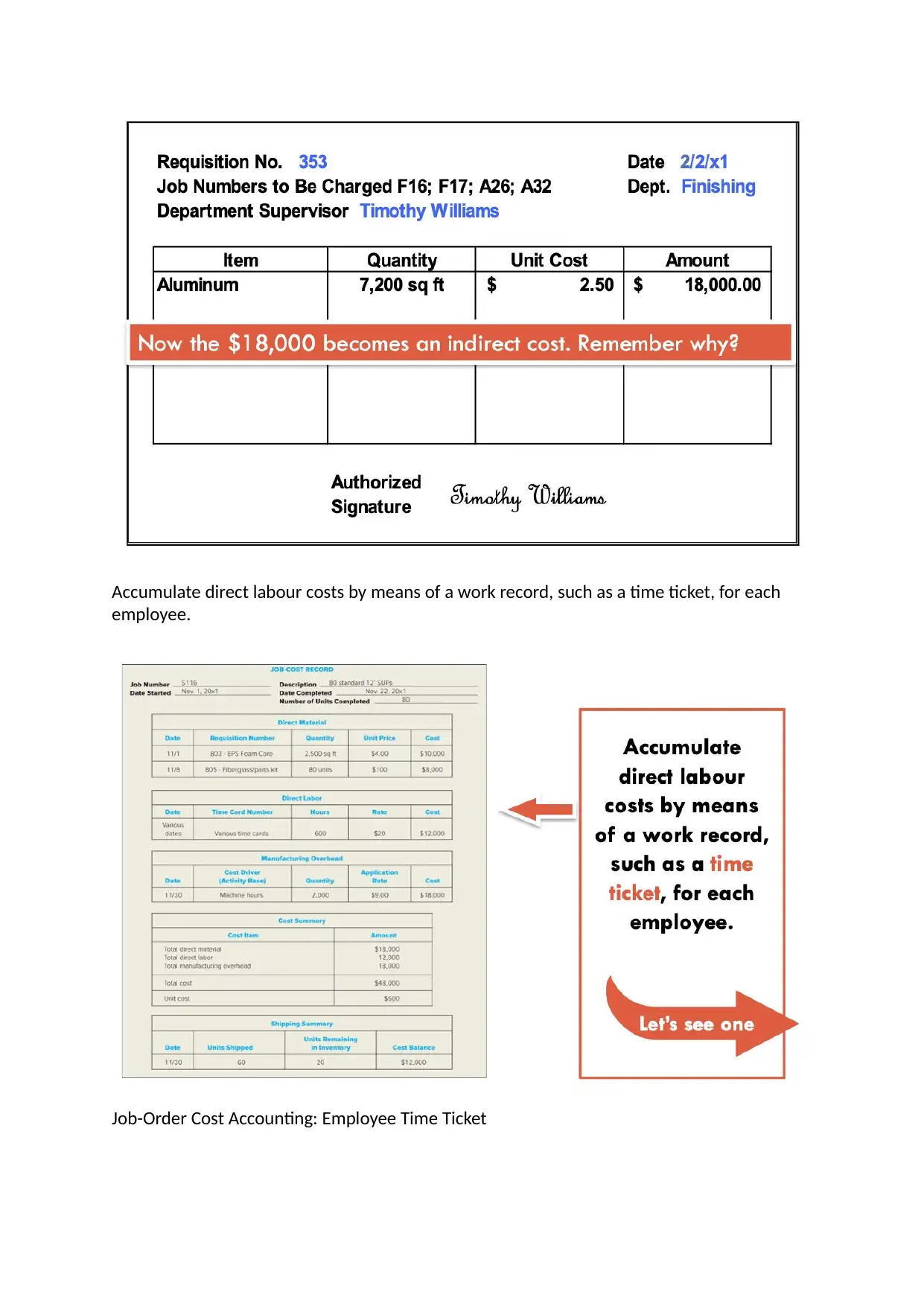
Accumulate direct labour costs by means of a work record, such as a time ticket, for each
employee.
Job-Order Cost Accounting: Employee Time Ticket
employee.
Job-Order Cost Accounting: Employee Time Ticket
Paraphrase This Document
Need a fresh take? Get an instant paraphrase of this document with our AI Paraphraser
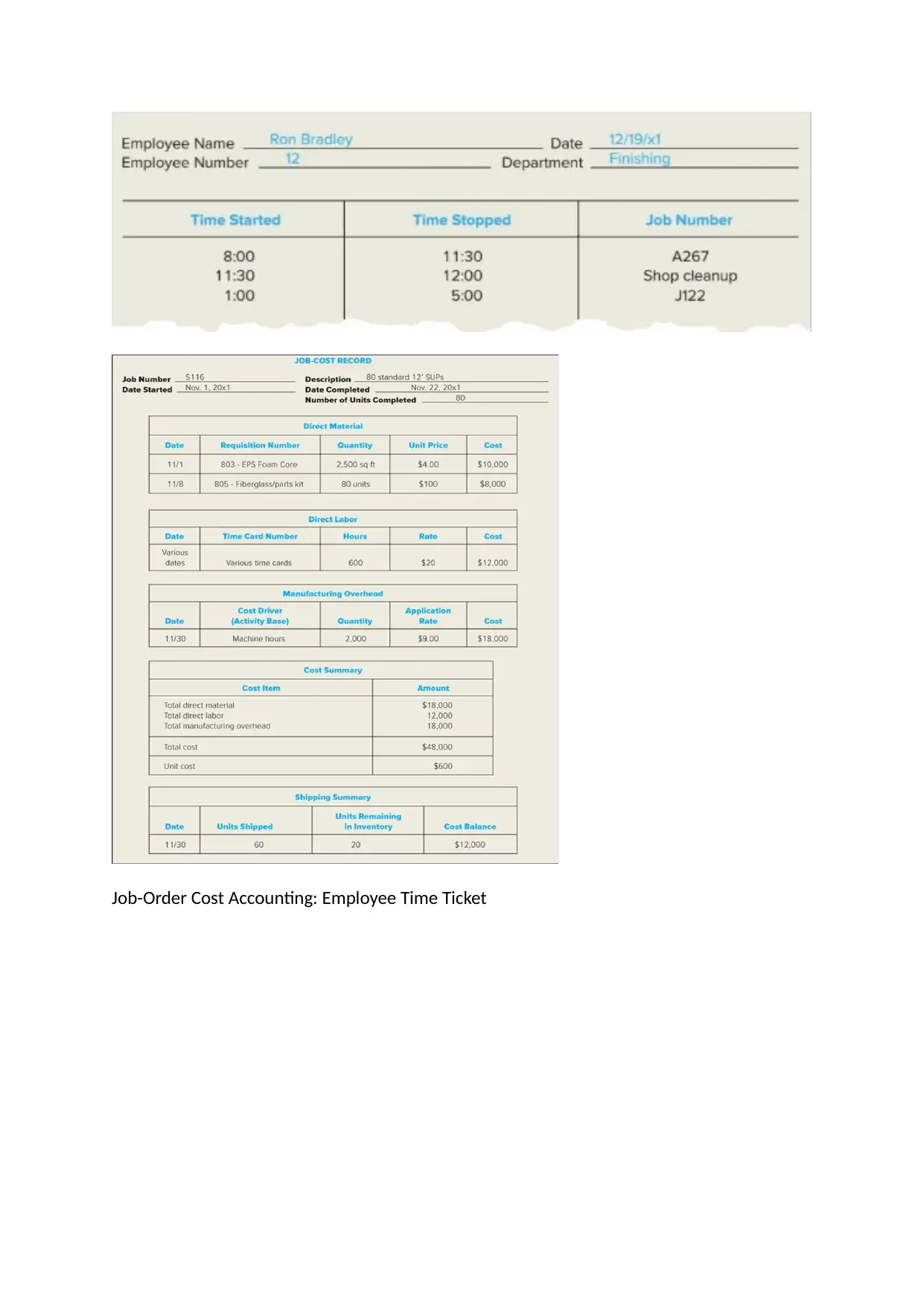
Job-Order Cost Accounting: Employee Time Ticket
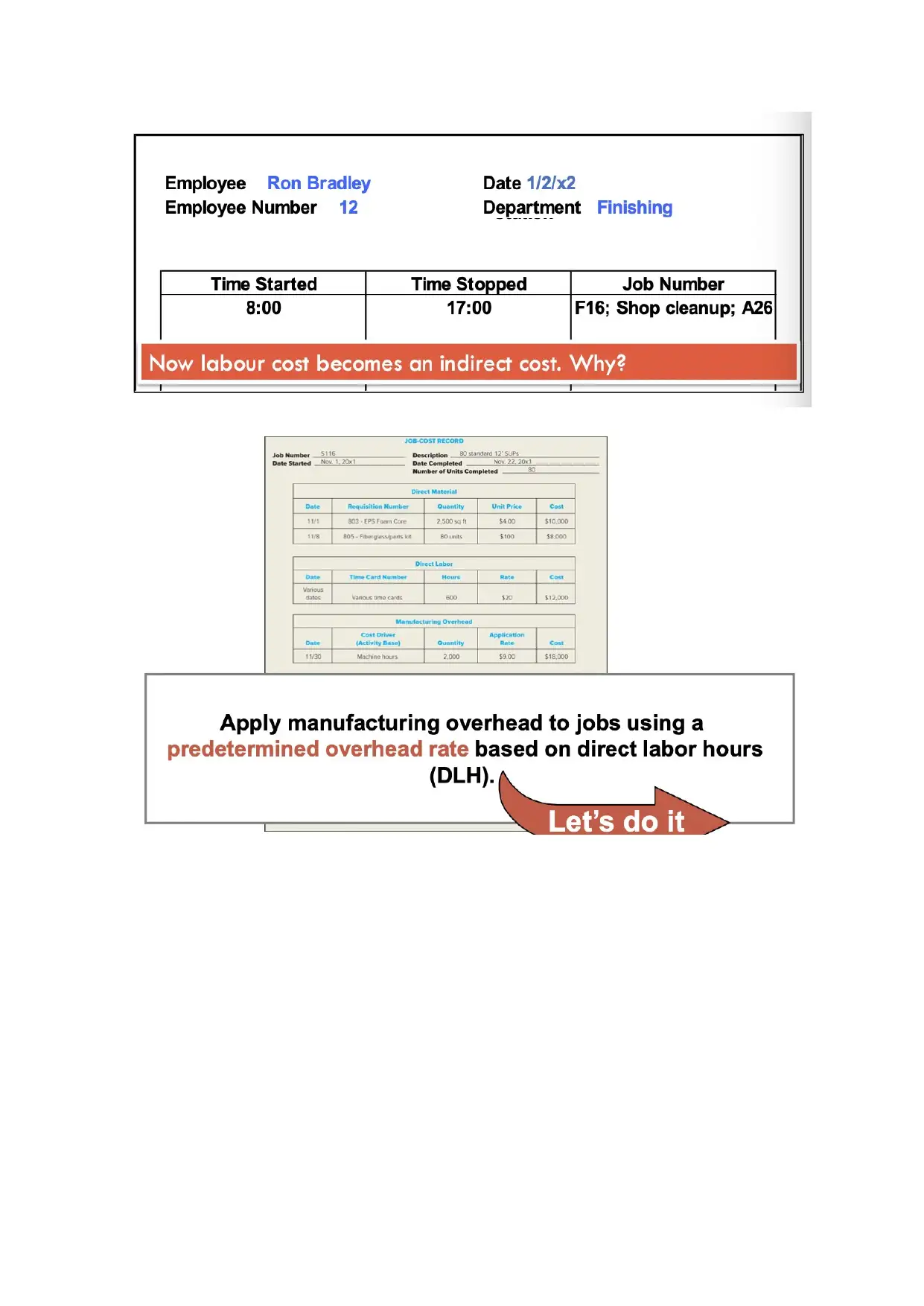
⊘ This is a preview!⊘
Do you want full access?
Subscribe today to unlock all pages.

Trusted by 1+ million students worldwide
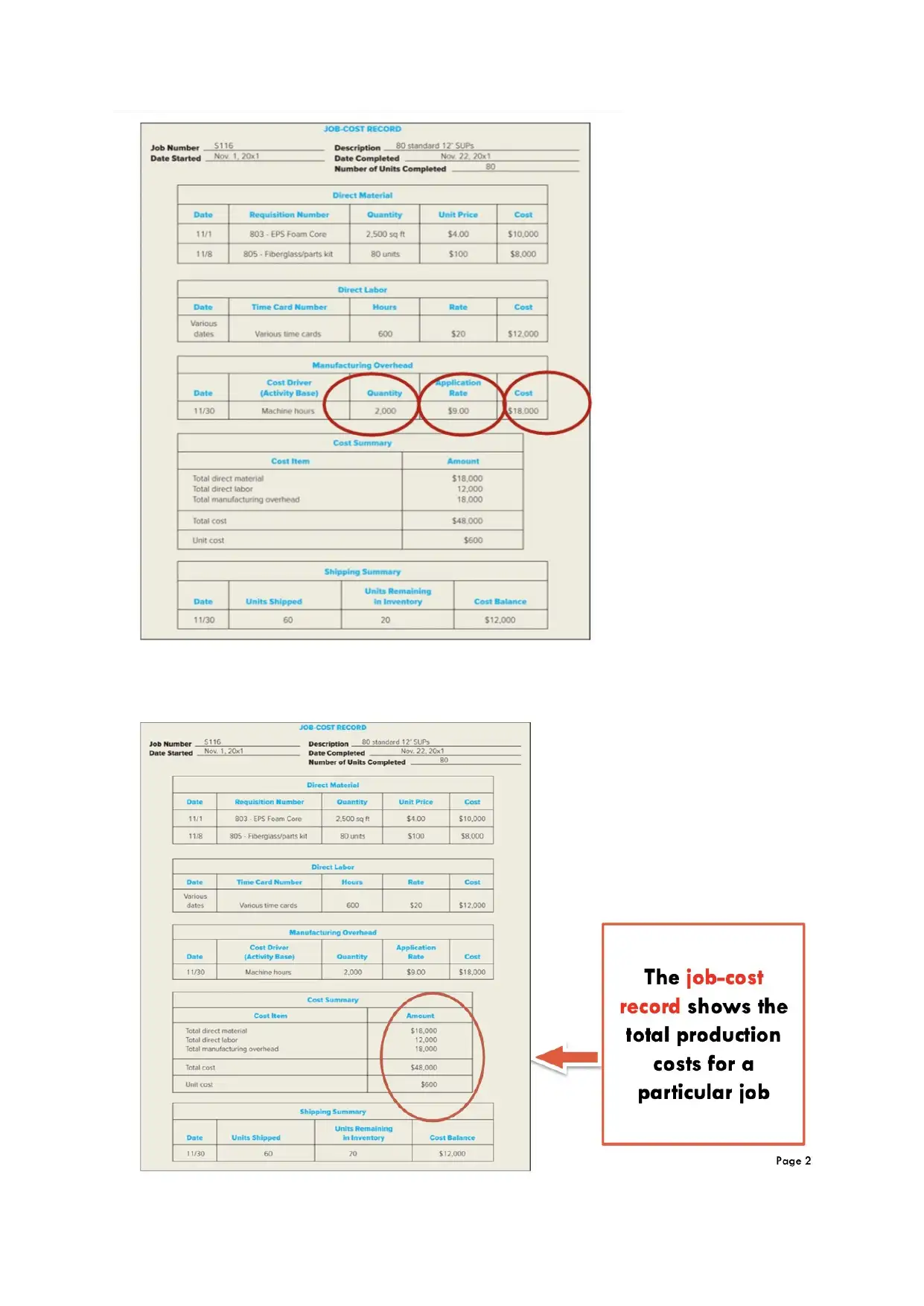
Paraphrase This Document
Need a fresh take? Get an instant paraphrase of this document with our AI Paraphraser
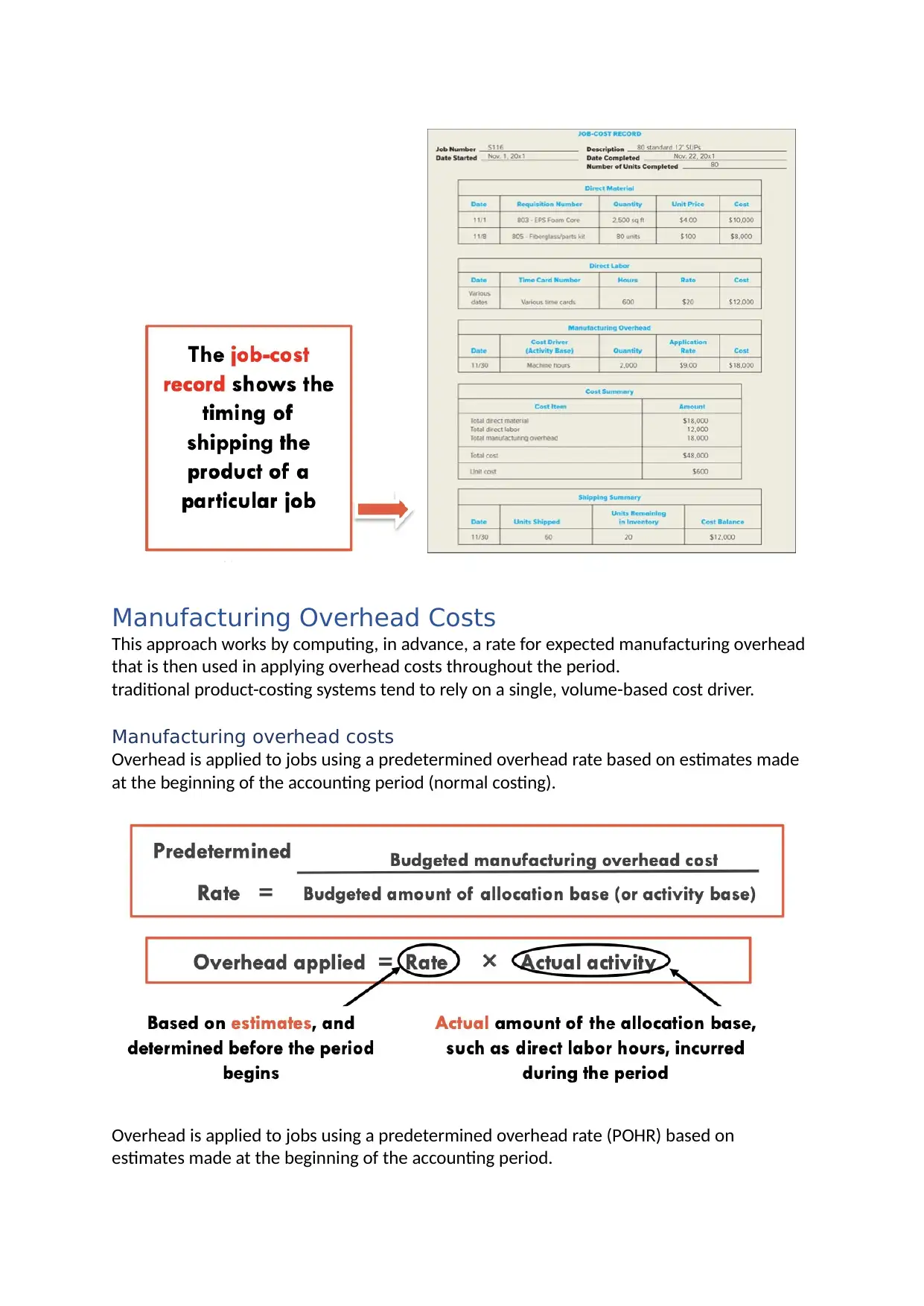
Manufacturing Overhead Costs
This approach works by computing, in advance, a rate for expected manufacturing overhead
that is then used in applying overhead costs throughout the period.
traditional product-costing systems tend to rely on a single, volume-based cost driver.
Manufacturing overhead costs
Overhead is applied to jobs using a predetermined overhead rate based on estimates made
at the beginning of the accounting period (normal costing).
Overhead is applied to jobs using a predetermined overhead rate (POHR) based on
estimates made at the beginning of the accounting period.
This approach works by computing, in advance, a rate for expected manufacturing overhead
that is then used in applying overhead costs throughout the period.
traditional product-costing systems tend to rely on a single, volume-based cost driver.
Manufacturing overhead costs
Overhead is applied to jobs using a predetermined overhead rate based on estimates made
at the beginning of the accounting period (normal costing).
Overhead is applied to jobs using a predetermined overhead rate (POHR) based on
estimates made at the beginning of the accounting period.
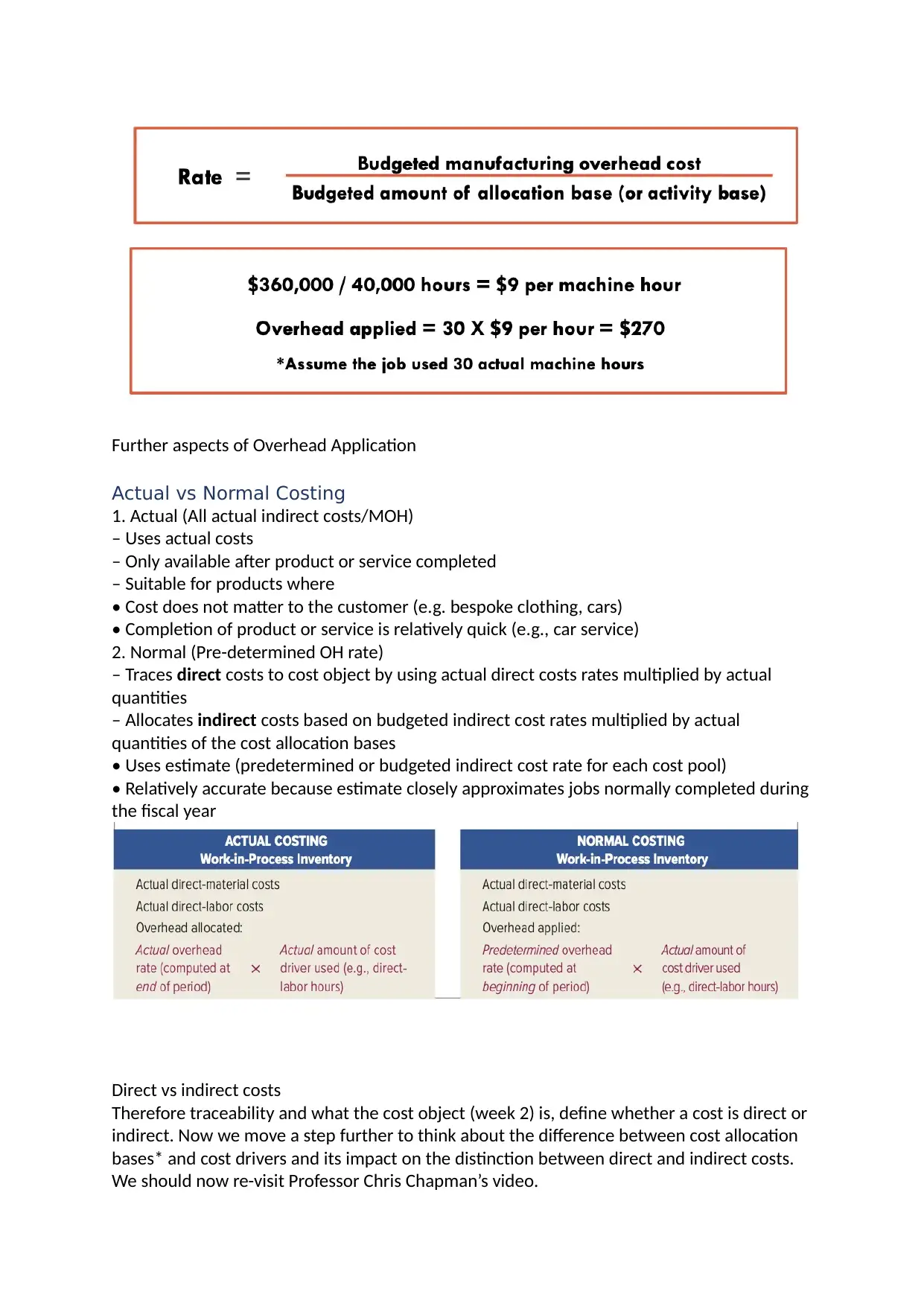
Further aspects of Overhead Application
Actual vs Normal Costing
1. Actual (All actual indirect costs/MOH)
– Uses actual costs
– Only available after product or service completed
– Suitable for products where
• Cost does not matter to the customer (e.g. bespoke clothing, cars)
• Completion of product or service is relatively quick (e.g., car service)
2. Normal (Pre-determined OH rate)
– Traces direct costs to cost object by using actual direct costs rates multiplied by actual
quantities
– Allocates indirect costs based on budgeted indirect cost rates multiplied by actual
quantities of the cost allocation bases
• Uses estimate (predetermined or budgeted indirect cost rate for each cost pool)
• Relatively accurate because estimate closely approximates jobs normally completed during
the fiscal year
Direct vs indirect costs
Therefore traceability and what the cost object (week 2) is, define whether a cost is direct or
indirect. Now we move a step further to think about the difference between cost allocation
bases* and cost drivers and its impact on the distinction between direct and indirect costs.
We should now re-visit Professor Chris Chapman’s video.
Actual vs Normal Costing
1. Actual (All actual indirect costs/MOH)
– Uses actual costs
– Only available after product or service completed
– Suitable for products where
• Cost does not matter to the customer (e.g. bespoke clothing, cars)
• Completion of product or service is relatively quick (e.g., car service)
2. Normal (Pre-determined OH rate)
– Traces direct costs to cost object by using actual direct costs rates multiplied by actual
quantities
– Allocates indirect costs based on budgeted indirect cost rates multiplied by actual
quantities of the cost allocation bases
• Uses estimate (predetermined or budgeted indirect cost rate for each cost pool)
• Relatively accurate because estimate closely approximates jobs normally completed during
the fiscal year
Direct vs indirect costs
Therefore traceability and what the cost object (week 2) is, define whether a cost is direct or
indirect. Now we move a step further to think about the difference between cost allocation
bases* and cost drivers and its impact on the distinction between direct and indirect costs.
We should now re-visit Professor Chris Chapman’s video.
⊘ This is a preview!⊘
Do you want full access?
Subscribe today to unlock all pages.

Trusted by 1+ million students worldwide
1 out of 26
Related Documents
Your All-in-One AI-Powered Toolkit for Academic Success.
+13062052269
info@desklib.com
Available 24*7 on WhatsApp / Email
![[object Object]](/_next/static/media/star-bottom.7253800d.svg)
Unlock your academic potential
Copyright © 2020–2025 A2Z Services. All Rights Reserved. Developed and managed by ZUCOL.



